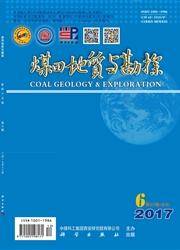

 中文摘要:
中文摘要:
为研究地堑和地垒构造对采煤沉陷的影响。建立了仅地质构造形式不同即地堑和地垒,而含煤岩系地层结构及其力学性质完全相同的两个采煤沉陷模型。然后采用东北大学岩石破裂与失稳分析系统RFPA对这两个模型分别进行开采条件相同的数值模拟试验.试验结果表明:在相同的开采强度下。地堑构造形式下的地表下沉幅度小,形成连续的弯曲下沉,但下沉盆地范围较大,采煤沉陷相对较弱。因此,地堑构造具有较强的抗扰动能力;地垒构造形式下的地表下沉幅度较大,易于形成不连续变形如槽型塌陷等,而下沉盆地范围较小,开采时较容易引起地表环境的损害,因此,地垒构造抗扰动能力较弱.图4,表3,参11.
 英文摘要:
英文摘要:
Two coal mining subsidence models were built which the structure of stratum and physical mechanics were identical expect that the form of geological structure were different. One form of geological structure was graben, the other was horst. The two models were tested in the same mining conditions with Rock Failure Process Analysis (RFPA) system which was developed by Northeastern University. The results indicate that, under the graben geological structure form, the subsidence of land surface is smaller, the range of the subsidence basin is larger and the bend is continuous, therefore the movement and deformation of the cover and its damage to the ground geological environment are not evident; whereas under horst geological structure form, the situation is contrary to which mentioned above. A conclusion can be obtained from the test that the ground environment hazards in coal mining areas are controlled by the graben and horst geological structure forms. 4figs., 3tabs., 11refs.
 同期刊论文项目
同期刊论文项目
 同项目期刊论文
同项目期刊论文
 期刊信息
期刊信息
